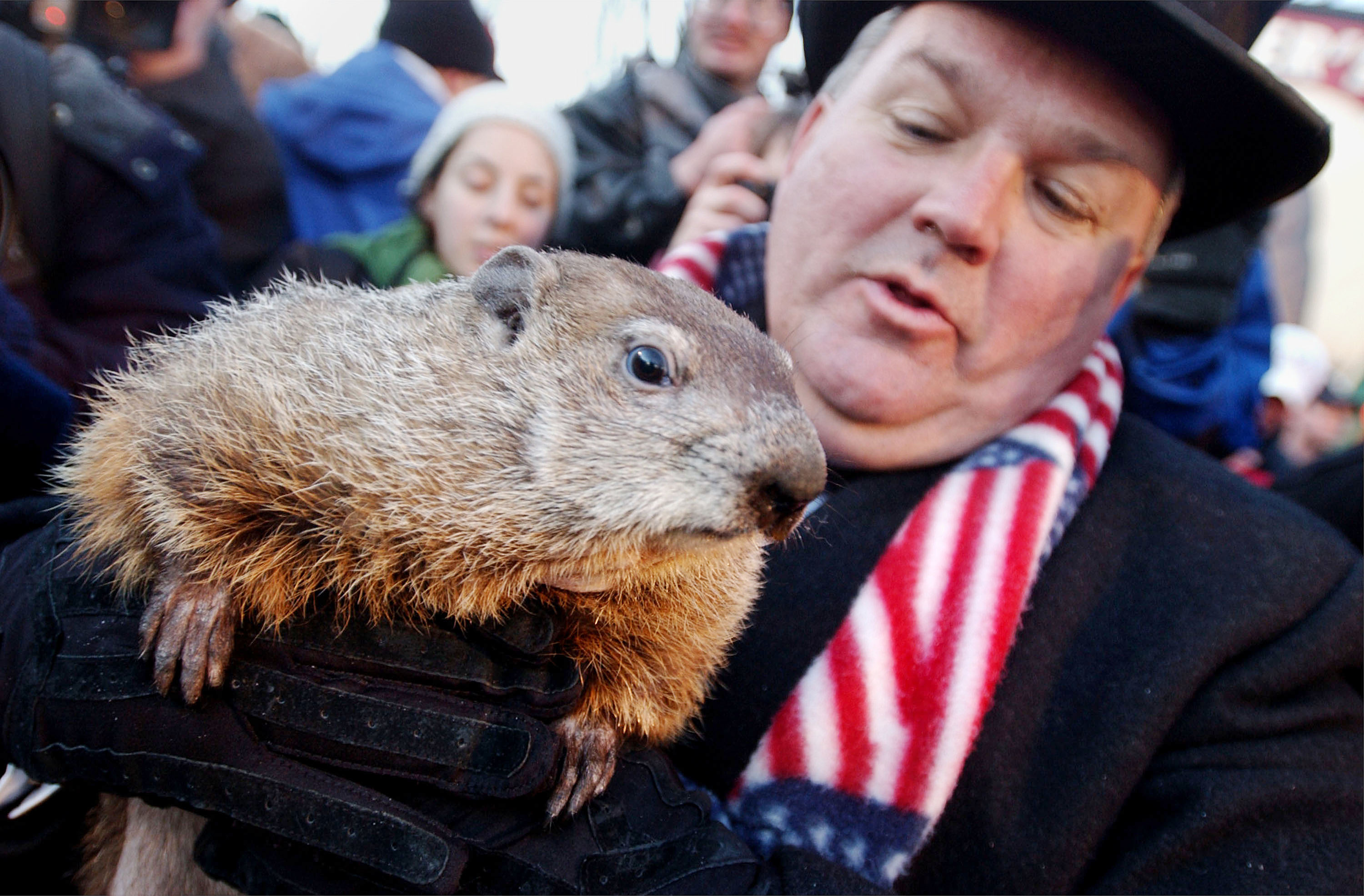What to Know
- Punxsutawney Phil is forecasting an early spring from the largest and best known Groundhog Day celebration in the United States at Gobbler’s Knob in western Pennsylvania.
- The annual event, which was held shortly after sunrise on Friday, Feb. 2, 2024, is a tongue-in-cheek ritual in which Phil’s handlers reveal whether the groundhog has seen his shadow.
- This year, they say the rodent did not see his shadow and that will usher in early springlike weather. They say when he does see his shadow, that presages six more weeks of winter.
Editor's Note (Feb. 2, 2024, 7:26 a.m.): Punxsutawney Phil didn't see his shadow, meaning an early spring.
Punxsutawney Phil predicted an early spring Friday in Gobbler’s Knob, Pennsylvania, the scene of the country’s largest and best known Groundhog Day celebration in the United States.
The annual event is a tongue-in-cheek ritual in which Phil’s handlers, members of a club with roots in the late 19th century, reveal whether the groundhog has seen his shadow.
Get top local stories in Philly delivered to you every morning. Sign up for NBC Philadelphia's News Headlines newsletter.
Just after sunrise Friday, the Punxsutawney Groundhog Club announced Phil did not see his shadow, which will usher in early springlike weather. The groundhog seeing his shadow presages six more weeks of winter, according to the group.
"An early spring is on its way," one of the groundhog's handlers said while reading from a scroll. The claim is that the handlers communicate with Phil in "Groundhogese."
About 10,000 people have made their way in recent years to Punxsutawney, where festivities begin in the dead of night and culminate in the midwinter forecast. A bundled-up crowd, some wearing groundhog-themed hats, watched musical performances and fireworks as they waited for sunrise and the appearance of Punxsutawney Phil.
Pennsylvania Gov. Josh Shapiro took the stage before Phil to urge people around the world watching the festivities to come to Punxsutawney next year. Shapiro also announced the famed groundhog is the new official meteorologist for Pennsylvania.
“Punxsutawney is the center of the universe right now and I love that you’re all here,” Shapiro said.
Phil predicts more winter far more often than he sees an early spring, not a bad bet for February and March in western Pennsylvania. A federal agency took a look at his record last year and put his accuracy rate at about 40%.
The tradition of celebrating the midpoint between the shortest day of the year on the winter solstice and the spring equinox goes back many centuries in European farm life.
There are more than a dozen active groundhog clubs in Pennsylvania, some dating back to the 1930s, and weather-predicting groundhogs have appeared in at least 28 U.S. states and Canadian provinces.
The 1993 blockbuster film “Groundhog Day,” starring Bill Murray, fueled interest in Punxsutawney Phil and inspired informal observations far and wide.
When he's not making his annual prognostication, Phil lives in a customized space beside the Punxsutawney Memorial Library, with a window where library patrons can check out his burrow. Back in 2009, library workers said Phil had somehow managed to escape three times, climbing into the library ceiling and dropping into offices about 50 feet away. He wasn’t injured.
Some dismiss the Punxsutawney event as an unworthy rival to their own festivities, which they say forecast more accurate weather predictions. There have been weather-predicting groundhogs in at least 28 U.S. states and Canadian provinces, and less formal celebrations far and wide.
One thing it's not: serious business.
“We know this is silly; we know this is fun,” said Marcy Galando, executive director of the Punxsutawney Groundhog Club. “We want people to come here with a sense of humor.”
What are Groundhog Day's origins?
Celtic people across Europe marked the four days that are midway between the winter solstice, the spring equinox, the summer solstice and the fall equinox. What the Celts called Imbolc is also around when Christians celebrate Candlemas, timed to Joseph and Mary's presentation of Jesus at the Temple in Jerusalem.
Ancient people would watch the sun, stars and animal behavior to guide farming practices and other decisions, and the practice of watching an animal’s emergence from winter hibernation to forecast weather has roots in a similar German tradition involving badgers or bears. Pennsylvania Germans apparently substituted the groundhog, endemic to the eastern and midwestern United States.
Historians have found a reference in an 1841 diary to groundhog weather forecasts in early February among families of German descent in Morgantown, Pennsylvania, according to the late Don Yoder, a University of Pennsylvania professor whose 2003 book about Groundhog Day explored the Celtic connection.
Yoder concluded the festival has roots in “ancient, undoubtedly prehistoric, weather lore.”
Why is Groundhog Day celebrated in Punxsutawney?
Punxsutawney is an area where Pennsylvania Germans settled — and in the late 1880s started celebrating the holiday by picnicking, hunting and eating groundhogs.
Members of Punxsutawney Groundhog Club, organized in 1899, care for Phil at a customized space beside Punxsutawney Memorial Library — where there's a window with a view into the creature's burrow.
The Punxsutawney groundhog makes predictions but he's not always predictable. The designated groundhog emerged before sunrise in 1929 and didn't come out until late afternoon in 1941.
The Bill Murray movie caused such a resurgence of interest that two years after it came out, event organizers voiced concern about rowdy crowds drinking all night, people climbing trees and others stripping to their underwear. In 1998, a groundhog club leader wearing a $4,000 groundhog suit reported being assaulted by a half-dozen young men.
Alcohol is now prohibited at Gobbler's Knob, Phil's spot some 80 miles northeast of Pittsburgh.
Does Phil have any competition?
The early festivities in Punxsutawney were followed in 1907 by folks in Quarryville, a farming area in Lancaster County in Pennsylvania's southeastern corner. The roughly 240 members of the Slumbering Groundhog Lodge there report the winter forecast from Octoraro Orphie, or least via his well-preserved remains.
Quarryville Lodge board chair Charlie Hart said the organization has dinners and other social events throughout the year but is largely focused on Groundhog Day.
Hart credits Orphie as a far better forecaster than Phil.
“Octoraro Orphie has never been wrong," Hart said. "This is the 116th year, and in the previous 115 he has been right on the money every year.”
Whistle pigs on the menu?
The groundhog is a member of the squirrel family and related to chipmunks and prairie dogs. It's also known as a woodchuck, a whistle pig — or in the parlance of Pennsylvania Dutch, a language with German roots, a “grundsau.”
Groundhogs are herbivores that are themselves edible to humans, although they are not widely consumed. Their lifespan in the wild is typically two or three years.
The Pennsylvania Game Commission says about 36,000 hunters reported killing more than 200,000 groundhogs last year.
Game Commission spokesperson Travis Lau found groundhogs a bit stinky to clean, with thick skin.
“It was actually really good, no doubt about it — and to my taste, more like beef than venison is,” Lau said. “The whole family ate it and liked it, and everybody had apprehensions."
Some cooks advise groundhogs are best taken when they are young and after clover is in bloom, since a clover diet is thought to improve the meat's taste.
When did groundhog clubs and lodges first spring up?
Starting in the 1930s, groundhog lodges opened in eastern Pennsylvania. They were social clubs with similarities to Freemasonry.
Intended to preserve Pennsylvania's German culture and traditions, clubs would sometimes fine those who were caught speaking anything but their Pennsylvania Dutch language at meetings. They were traditionally all-male groups and 15 such clubs remain active.
They all share the unifying feature of a groundhog's weather prognostication, said William W. Donner, a Kutztown University anthropology professor and author of “Serious Nonsense,” a book about such lodges and other efforts to preserve German heritage.
“I think it's just one of these traditional rituals that people enjoy participating in, that maybe take them away from modern life for 15 minutes,” Donner said.
What's Phil's record for getting his weather prediction right?
Some well-meaning efforts have sought to determine Phil's accuracy, but what “six weeks of winter” means is debatable. Claims that a groundhog has or has not seen its shadow — and that it's able to communicate that to a human — are also fair territory for skeptics and the humor impaired.
By all accounts, Phil predicts more winter far more often than he predicts an early spring.
Groundhogs are mostly solitary creatures who start to emerge in midwinter to find a mate. The science behind whether they can make any accurate weather predictions is problematic at best.
Among the skeptics is the National Centers for Environmental Information, within the National Oceanic and Atmospheric Administration. The government agency last year compared Phil's record with U.S. national temperatures over the prior decade and concluded he was right only 40% of the time.
Sign up for our Breaking newsletter to get the most urgent news stories in your inbox.



